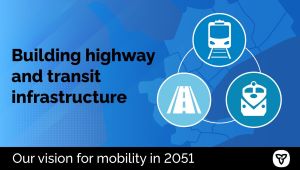
Ontario Releases Plan to Build Transportation and Transit Infrastructure in the Greater Golden Horseshoe
With the population of the Greater Golden Horseshoe expected to reach almost 15 million people over the next 30 years, the Ontario government today released Connecting the GGH: A Transportation Plan for the Greater Golden Horseshoe. With more than 100 immediate and near-term actions, including building Highway 413 and the Bradford Bypass, the plan will support population and employment growth, reduce gridlock, connect communities, and improve people’s access to jobs, housing, health care and education.
“Our government is saying ‘yes’ to building the roads, highways and public transit needed to unlock our full economic potential and keep our province moving forward,” said Premier Doug Ford. “As we attract more skilled workers to Ontario, we need to build more roads and highways to keep up with population growth. Highway 413 and the Bradford Bypass are a critical part of our plan to build Ontario as we connect communities, reduce gridlock and get goods to market sooner.”
In addition to building new highways to address gridlock, the province is also moving ahead with the largest subway build in Canadian history alongside the expansion of regional passenger rail services. Doing so will ensure the province delivers on its mandate of two-way, all-day, 15-minute service.
“Our government is building roads, highways and transit to connect communities, fight gridlock and keep goods and people moving across the province, including in Ontario’s economic engine, the Greater Golden Horseshoe,” said Caroline Mulroney, Minister of Transportation. “No matter how you choose to move, we are building all forms of transportation infrastructure to help you get to where you need to go more safely, quickly, and conveniently. Our bold vision will create jobs, boost Ontario’s competitiveness and meet the demands of people in this rapidly growing region.”
Connecting the GGH: A Transportation Plan for the Greater Golden Horseshoe is an evergreen, living document that will continuously evolve, be updated and improved to meet forecasted growth and future needs of the region. To this end, the province will continue to work closely with municipal, Indigenous and Francophone communities, transportation agencies, industry and businesses to align planning and keep this vital region moving.
“The Greater Golden Horseshoe is home to diverse communities with different transportation needs,” said Vijay Thanigasalam, Parliamentary Assistant to the Minister of Transportation. “Our government has developed a transportation plan for the Greater Golden Horseshoe that is informed by engagement with local community members, partners, and stakeholders.”
As part of the plan, the province will establish a taskforce of local leaders to advise on additional ways to improve connections between modes and communities, support regional tourism and help keep people and goods moving.
Quick Facts
- The Greater Golden Horseshoe is the urban region centred around the City of Toronto. It extends from Waterloo, Wellington and Brant County in the west, Peterborough and Northumberland in the east, Simcoe County in the north, and Haldimand and Niagara in the south.
- By 2051, population and employment figures in the Greater Golden Horseshoe are forecast to grow from 10 million to 14.9 million people, and 4.9 million to 7 million jobs, respectively.
- The region is a nationally significant hub for goods movement and business travel that sees $1.16 trillion in goods transported annually on its highways.
- Ontario is developing regional plans that will help build a better transportation system across the province. In 2020, Ontario released the Connecting the Southwest: A Draft Transportation Plan for Southwestern Ontario and Connecting the North: A Draft Transportation Plan for Northern Ontario. Regional planning is also underway for eastern Ontario, as well as an integrated Ontario-wide strategy.
Quotes
"Investments in regional connectivity boost Ontario’s quality of life and global competitive advantage. This plan helps inform and prioritize essential investments such as Highway 413 and two-way, all day GO train service. The plan is forward-thinking in that it takes into account both the experience of commuters and the people who bring them the food, medicine and goods they need. We look forward to working with the expert panel to develop ideas that embrace new technologies and ensure Ontarians are able to connect throughout the GGH in a safe, efficient and sustainable way."
- Todd Letts
MBA CCE, Chief Executive Officer, Brampton Board of Trade
"Today’s announcement by the Ford government is another step forward in strengthening transit infrastructure in Ontario while generating thousands of jobs for our members and workers across the skilled-trades, while spurring economic development and competitiveness for the province. Minister Mulroney continues to demonstrate progressive leadership in investing in critical infrastructure, like Highway 413, that will aim to address future growth and demands of our municipalities with a significant focus on mobility, job creation, improving the flow of goods and services and building a stronger, resilient transit plan for Ontario."
- Joseph Mancinelli
LiUNA International Vice President and Regional Manager of Central and Eastern Canada
"This plan is a big step forward in building the kind of integrated, globally competitive system that will be critical to our economic recovery. Ten-minute-or-better transit service and two-way, all-day 15-minute GO rail service, as well as improved service and fare integration are great news for our economy. We applaud wise investments in projects that will contribute to the efficient movement of goods across the region for decades to come."
- Jan Da Silva
President and CEO, Toronto Region Board of Trade
